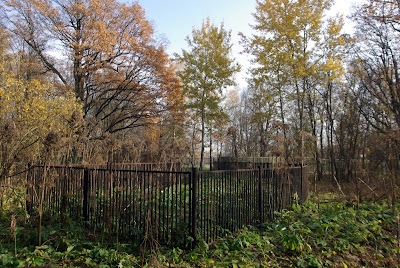 The view from half-way up one of the highest buildings in Moscow now, where one of the British accounting firms where I work, has its offices. The Moscow river is in the middle ground and the famous White House, seat of some parts of the Russian federal government, is at the top. This was the building Yelstin's forces shelled during the failed attempt to assert parliamentary government over presidential diktat in 1993.
The view from half-way up one of the highest buildings in Moscow now, where one of the British accounting firms where I work, has its offices. The Moscow river is in the middle ground and the famous White House, seat of some parts of the Russian federal government, is at the top. This was the building Yelstin's forces shelled during the failed attempt to assert parliamentary government over presidential diktat in 1993.This is the little church (of Nikola in Khamovniki) near Tolstoy's Moscow property, which is yet another museum I have yet to visit. It is hard to photograph as it is surrounded by other buildings. By contrast, nothing much but mud and wreckage surrounds the sheds at the end of the purple Metro line which takes me to and from Planernaya station every working day. Large parts of Soviet-era Moscow look like this. It is a miracle anything works: yet the metro is actually far more reliable than the London underground, whose sheds, I imagine, are a lot smarter than this.

Below is what it so me one of the most hideous buildings in Moscow, though one of the most lavish--the two often go together in Modern Russia. It is the reconstructed Cathedral of Christ the Redeemer, which is a replica of the original, built in the 1880s to commemorate the defeat of Napoleon, and which was blown up in 1932 as part of the reconstruction of Moscow along Soviet lines. It was here that the great Palace of the Soviets was to be constructed, with its 300-foot high statue of Lenin on top. But the ground could not take the projected weight, and money ran out, so the project was abandoned after only the foundations had been dug. In the 1950s the hole was converted into a massive, heated, open-air pool, which became known popularly as the swimming pool of Christ the Redeemer. When I visited the Cathedral with some friends, the Russian lady accompanying us was told not to speak to me and my friend from Scotland about the church, especially in English, as she was not an accredited guide. The official who said this, a smart young man who looked like a Mormon might in Russia, was entirely serious. This is a good example of the fact that the Russian church today has the most oppressive and unpleasant officialdom of any institution in this country that I have had contact with. The hideous car outside, for a wedding, seemed to me entirely appropriate to such an ugly-spirited place.

Below is part of one of the sales counters in an ecclesiastical outfitters to the south of the city centre, very close to where Walter Duranty used to live.

Other aspects of modern Russian life are much more appealing...

This is an advertisement for a mobile phone--Motorola--in the parking lot outside our local supermarket.
And finally a Russian street scene such as the pedestrian encounters fifty times a day.
 And very finally, a foreigner: it is seldom hard to tell the difference. Standing in front of one of the million Moscow building sites, he, like me, was waiting to get the marshrutka to the largest foreign-owned media publishing company in Russia. He was tapping his right foot impatiently.
And very finally, a foreigner: it is seldom hard to tell the difference. Standing in front of one of the million Moscow building sites, he, like me, was waiting to get the marshrutka to the largest foreign-owned media publishing company in Russia. He was tapping his right foot impatiently.
 And very finally, a foreigner: it is seldom hard to tell the difference. Standing in front of one of the million Moscow building sites, he, like me, was waiting to get the marshrutka to the largest foreign-owned media publishing company in Russia. He was tapping his right foot impatiently.
And very finally, a foreigner: it is seldom hard to tell the difference. Standing in front of one of the million Moscow building sites, he, like me, was waiting to get the marshrutka to the largest foreign-owned media publishing company in Russia. He was tapping his right foot impatiently.










































